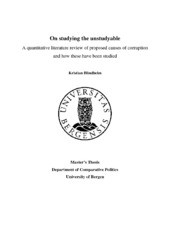| dc.description.abstract | This thesis is a quantitative review of research on the causes of corruption. The aim is twofold: firstly to establish the degree of agreement between researchers regarding the causal effect of seven different explanatory dimensions on corruption. These explanatory dimensions are: economic liberalization, level of democracy, regime transitions, the strength of democratic traditions, the presence of a free media, level of economic development and natural resource dependency. I find that there is high agreement that economic liberalizations and regime transitions lead to more corruption. There is also high consensus that the presence of a free media and high economic development, respectively, lead to less. Concerning the effect of level of democracy, democratic traditions and natural resource dependency the findings are more diverse. About half of prior research concludes that level of democracy and stronger democratic traditions lead to less corruption. Also about half conclude that natural resource dependency leads to more corruption. The second aim of this thesis is to discover whether the disagreement between researchers can be explained by the data they have applied as operationalizations of corruption as the dependent variable. This is done through a series of logistic regressions, where the explanatory variables are the different data sources on corruption. These fall into the categories perceptions based cross-national data", experience based cross national data" and country-or region-specific studies". The results show that applying experience based cross national data gives significantly lower likelihood for concluding that higher economic development leads to less corruption. It also makes it less likely to conclude that natural resources lead to more corruption. Applying perceptions based cross national data in some instances provide higher likelihood for observing significant effects of the explanatory dimensions treated in this thesis and sometimes lower likelihood. An interesting finding is that the Transparency International Corruption Perceptions Index and studies conducted with country- or region specific foci agree" on the effects on corruption of all of the treated explanatory dimension where comparison is possible. This is counter to what is assumed based in theory. | en_US |
